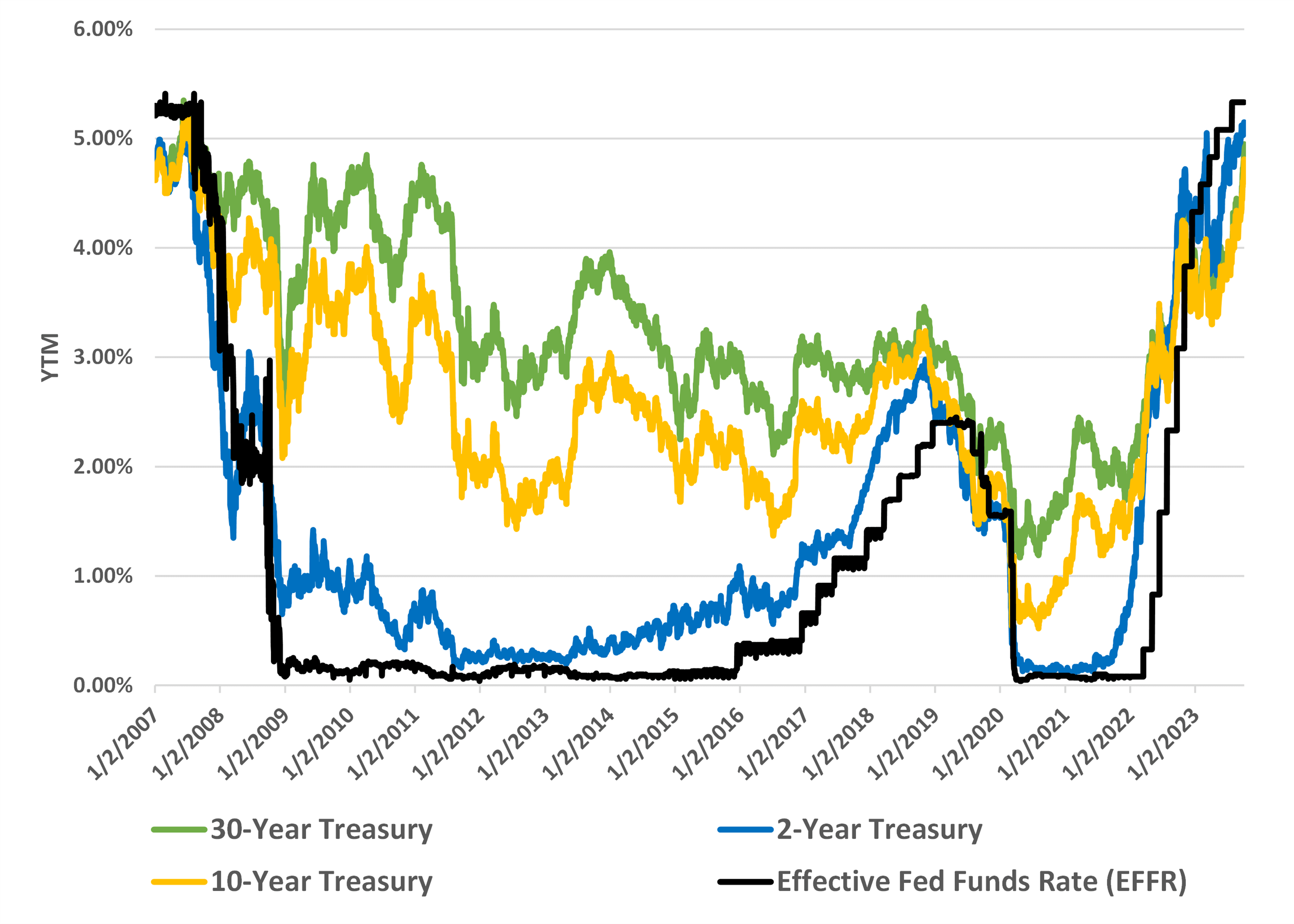So far in 2023, Bondsavvy has made 12 new corporate bonds recommendations, of which 11 remain 'buys.' These 11 best corporate bonds to buy 2023 include four new bond recommendations we made during the October 5, 2023 edition of The Bondcast.
This fixed income blog post previews our 11 best corporate bonds to buy 2023, as well as all 63 corporate bonds we currently rate as buy or hold.
- We don't see a near-term impetus for longer-term US Treasury yields to fall given trillions in fiscal US deficits, significant US Treasury issuance, stubborn inflation, and a relatively strong US economy. As high yield corporate bonds generally have lower sensitivity to US Treasury yields than investment grade bonds, our recent bonds picks have had a greater proportion of high yield bonds.
- Of our 11 best corporate bonds to buy 2023, eight have high yield bond ratings and three are investment grade corporate bonds.
- Maturity dates of our 2023 bond recommendations have ranged from 2028 to 2033. These recommendations enable subscribers to benefit from currently high corporate bond yields and to lock in income for potentially 5 to 10 years. This is a compelling alternative to Vanguard money market funds, which have variable income that changes each month.
- On October 13, 2023, 8 of our 11 best corporate bonds to buy 2023 were priced within 1.1 points of their pick date price. The three remaining bond picks were +6.30, +1.33, and -5.10 points compared to their pick date prices. These recommended bonds have held their value despite a sharp recent increase in longer-term US Treasury yields.
- Of our 11 best corporate bonds to buy 2023, the median yield to maturity (YTM) on October 13 was 7.37%. Of all 63 current recommendations rated buy or hold, 38 (or 60%) had October 10 YTMs from 6.00% to 9.99%. Eighteen had YTMs from 5.10% to 5.99%, while 7 had YTMs of at least 10%.
Our Best Corporate Bonds To Buy 2023 Preview
Bondsavvy presents new corporate bond recommendations during The Bondcast, a quarterly webcast available exclusively to Bondsavvy subscribers. We then, during The Super Bondcast, update all of our corporate bond recommendations following quarterly earnings releases. Our next edition of The Super Bondcast will be November 16.
Figure 1 provides a summary of the corporate bonds we have recommended in 2023 that remain 'buys.' We recommended the sale of one 2023 recommendation on July 13, 2023. This bond was Mercer International 5.125% '29 (CUSIP 588056BB6), which we recommended subscribers sell at a -0.73% loss after it reported a weak Q1 2023 and gave uninspiring forward guidance.
For each bond, we indicate the pick date price, as well as each bond's price and YTM on October 13, 2023. As noted above, on October 13, 8 of 11 best corporate bonds to buy 2023 were still priced within 1.1 points of the pick date price. The median YTM of our best bonds to buy 2023 was 7.37% on October 13.
Subscribe to Bondsavvy to learn the names, CUSIPs, and investment rationale for all of our corporate bond recommendations.
Figure 1: Bond Prices of Our Best Corporate Bonds To Buy 2023 -- Pick Date vs. October 13, 2023
Bond by Pick Date | Pick Date Offer Price | Oct 13, 2023 Offer Price | Oct 13, 2023 Yield to Maturity |
| October 5, 2023 Pick Date | |||
| High yield bond 1 | 91.33 | 91.98 | 6.85% |
| Investment grade bond 1 | 96.25 | 96.67 | 5.42% |
| High yield bond 2 | 83.65 | 83.73 | 7.52% |
| High yield bond 3 | 97.73 | 98.18 | 7.59% |
| June 22, 2023 Pick Date | |||
| High yield bond 1 | 95.25 | 94.18 | 7.61% |
| High yield bond 2 | 93.53 | 93.34 | 8.81% |
| Investment grade bond 1 | 75.29 | 75.10 | 7.32% |
| Investment grade bond 2 | 86.19 | 81.09 | 7.33% |
| March 8, 2023 Pick Date | |||
| High yield bond 1 | 88.98 | 95.28 | 7.37% |
| High yield bond 2 | 91.47 | 92.80 | 8.82% |
| High yield bond 3 | 84.90 | 84.22 | 6.56% |
Source: Fidelity.com
The maturity dates of the best bonds to buy 2023 ranged from 2028 to 2033 and included bonds across nine different industry groups. We provide additional details on our recommended bonds' maturity-date and industry diversification later in this fixed income blog post.
Yield to Maturity Summary of Bondsavvy's Corporate Bond Recommendations
Our 11 best corporate bonds to buy 2023 aren't our only recommended bonds with high yields and strong total return potential. Of the 63 bond recommendations we currently rate 'buy' or 'hold,' 45 (or 71%) had YTMs of at least 6.00% on October 10, 2023.
As we discuss in our Eight Reasons Not To Own Vanguard VMFXX blog post, there is a big difference between a 7.00% corporate bond YTM and the recent VMFXX 7 day yield of 5.25%. The VMFXX 7 day yield is variable and changes every week. Vanguard VMFXX and other large money market funds cannot be counted on to lock in income for an extended period of time in the way corporate bonds with maturity dates and fixed coupons do.
Historically, Bondsavvy has advocated selling bonds before maturity to lock in capital appreciation and maximize total returns. Capital appreciation opportunities in 2022 and 2023 have been limited; however, our goal for the vast majority of our bond recommendations is to achieve corporate bond returns that exceed a recommended bond's quoted YTM.
Figure 2 shows the YTM distribution of the 63 bonds Bondsavvy rated 'buy' or 'hold' on October 10, 2023. For example, on October 10, 2023, 18 of our corporate bond recommendations had YTMs between 7.00% to 7.99%.
Figure 2: YTM Distribution of Bondsavvy's Bond Recommendations -- October 10, 2023
Source: Fidelity.com and FINRA TRACE data
Impact of US Treasury Yields on Bond Recommendation Selection
The maturity dates of our 2023 corporate bond recommendations ranged from 2028 to 2033, or approximately 5 to 10 years to maturity from the pick date. In addition, 8 of 11 best bonds to buy 2023 were high yield corporate bonds, which typically have a lower sensitivity to changes in US Treasury yields.
The shorter-term maturities, high yield bond ratings, and generally strong financial performance of our best corporate bonds to buy 2023 have enabled our recommended bonds to hold their value thus far in 2023. Many bonds in 2023 have not, as longer-term US Treasury yields have been rapidly increasing.
Bondsavvy Subscriber Benefit
How many hours per week can you spend evaluating corporate bond investments? Bondsavvy does the financial analysis for you and provides a select number of recommendations that can outperform the leading bond funds and ETFs.Get Started
As shown in Figure 3, the 10 year US Treasury yield hit a 52-week low of 3.30% on April 5, 2023. Since then, the 10 year Treasury yield increased 1.4 percentage points (or 140 "basis points") to 4.70% on October 12, 2023. The 30 year US Treasury yield made a similar upward move and has closed at 4.95% on several days in October 2023.
Figure 3: US Treasury Yields vs. Effective Fed Funds Rate -- January 4, 2021-October 12, 2023

Sources: US Treasury and The Federal Reserve Bank of New York.
Figure 3 shows how US Treasury yields have moved in relation to the effective fed funds rate ("EFFR"). The US Federal Reserve sets the target range of the fed funds rate, which currently stands at 5.25%-5.50%. The EFFR represents the volume-weighted median of fed funds transactions and stood at 5.33% on October 12, 2023, according to the Federal Reserve Bank of New York.
From early 2022 until October 2022, the 2-, 10-, and 30-year US Treasury YTMs were moving almost in lockstep with increases in the fed funds rate. The 2 year US Treasury yield, which is typically heavily influenced by the overnight fed funds rate, hit a 2022 peak of 4.72% on November 7, 2022. Two year yields then fell and then spiked to 5.00% on March 7, 2023, right before Silicon Valley Bank went under.
Our Current Strategy on Corporate Bond Maturities
Despite the "Eight Reasons Not To Own Vanguard VMFXX," investors have continued to pile into money market funds given high recent short term yields. While money market funds can be a short-term solution for some investors, their dividends vary monthly and could fall significantly the next time the US Federal Reserve materially lowers the fed funds rate. In fact, the September 2023 Fed dot plot is projecting 2.7 points of interest rate cuts by 2026.
In 2023, we have not recommended bonds with maturities of under four years. While 2 year US Treasury yields have recently been approximately 5%, our goal has been to lock in higher yields for a longer time period. In addition, as corporate bonds near maturity, their credit spreads, or the difference between a corporate bond's YTM and that of a US Treasury with a similar maturity date, typically shrink. In some cases, short-dated corporate bonds can have YTMs lower than those of US Treasurys with similar maturities. We, therefore, have seen limited compelling opportunities in short term corporate bonds in 2023 when compared to medium term bonds.
Our recently recommended corporate bonds with 2028 to 2033 maturities enable subscribers to achieve higher income for longer and to position themselves for potential capital appreciation opportunities. If bond prices fell, investors could hold these bonds (or even buy more at a lower price) knowing the bonds would be set to return to par value on the maturity date.
Bondsavvy Subscriber Benefit
Approximately 9,000 individual corporate bonds are available for trading each day online. Our corporate bond recommendations cut through the clutter to identify bonds that offer high coupons and upside potential relative to their risk.Get Started
Bond Maturity Date Summary of All 63 Bond Recommendations
On October 12, 2023, Bondsavvy had 63 total corporate bond recommendations, including 34 'buys' and 29 'holds.' These 63 bond recommendations include the 11 best corporate bonds to buy 2023 listed in Figure 1.
While, on October 12, 2023, 2-, 10-, and 30-year US Treasury yields were almost in parity (ranging from 4.70%-5.06%), this isn't always the case. Figure 4 compares US Treasury yields to the EFFR from January 2, 2007 to October 4, 2023.
During the last two sets of interest rate hikes (December 2015 to July 2019 (225 basis points of hikes) and March 2022 to July 2023 (525 basis points of hikes)), long and short US Treasury yields converged. As the 2015-2019 Fed rate hikes were nearing their end, the 10-30 "term premium," the difference between the 10-year and 30-year US Treasury YTMs, was 0.10% to 0.20% from April 16, 2018 to October 22, 2018.
The 2-10 term premium also fell, dropping to 0.11% (11 basis points) on December 4, 2018. Since 2007, the highest 10-30 term premium was 1.60% on November 10, 2010. The highest and lowest 2-10 term premiums were 2.91% on February 4, 2011 and -1.08% on July 3, 2023, respectively.
Figure 4: US Treasury Yields vs. EFFR -- January 2, 2007 to October 4, 2023

Source: US Treasury and The Federal Reserve Bank of New York.
While short-term US Treasury yields are closely tied to the fed funds rate, longer-term US Treasury yields can be harder to predict. A higher term premium can mean more income; however, there is also typically higher interest rate risk for longer-dated bonds.
In addition, with corporate bonds, US Treasury yields are only part of the story, as a corporate bond's credit spread can be a significant part of a corporate bond's yield to maturity. This is especially true with high yield corporate bonds, where the credit spread can make up the majority of a bond's YTM and drive the performance of a bond's price.
Figure 5 shows the distribution of maturity dates of Bondsavvy's 63 current corporate bond recommendations. As interest rates have risen, there have been substantially more compelling investment opportunities than there were in 2021 and most of 2020. This has been especially true for medium-term bonds, a significant portion of which had YTMs below 1.25% during 2021 and most of 2020.
Figure 5: Number of Bondsavvy Recommendations by Maturity Date Range as of October 12, 2023
Industry Groups of Our Bond Issuers
While we believe the overdiversification of bond funds and ETFs dilutes their investment returns, we do believe diversifying across industry groups is important. As of October 12, 2023, our corporate bond recommendations included 63 corporate bonds across 57 issuing companies and 16 industries.
Figure 6 shows the number of recommended issuing companies within each of the 16 industry groups where we have bond recommendations. For example, in the aerospace and defense sector, we have two issuing companies, for which one issuer we recommended two of its corporate bond CUSIPs.
Figure 6: Number of Issuers by Industry for Bondsavvy's Current Buy/Hold Recommendations

Diversifying across industry groups provides bond investors with several advantages, which include:
- Benefit from shrinking credit spreads (and likely rising bond prices) of an industry group delivering strong financial performance
- Reduce risk of having too many eggs in one industry basket to the extent an industry faces significant headwinds
- Increase exposure to industries that could benefit from positive macro factors
- Tailor your investment portfolio toward sectors where you have considerable personal expertise (you can't do that with a bond fund)
Why Subscribe to Bondsavvy Now
Warren Buffett once said: "Be fearful when others are greedy, and be greedy when others are fearful." With the Fed hiking rates over 5 percentage points since early 2022, many investors have fled the corporate bond market, and many bond prices have fallen.
With 10 year US Treasury yields recently reaching 16-year highs and many bonds of highly profitable companies trading at all-time high yields, bond investors have once-in-a-generation investment opportunities. While many investors have gravitated toward money markets, corporate bond investors can lock in high yields for longer and benefit from capital appreciation opportunities.
Bondsavvy gives you an edge so you can take advantage of new bond investing opportunities you may miss by trying to do it on your own. We believe we offer a higher level of expertise and a better value than personal financial advisors, as we spend 100% of our time on corporate bonds and charge a flat fee. We offer the potential to achieve higher investment returns vs. bond funds and empower you to create a portfolio tailored to your investment objectives.





